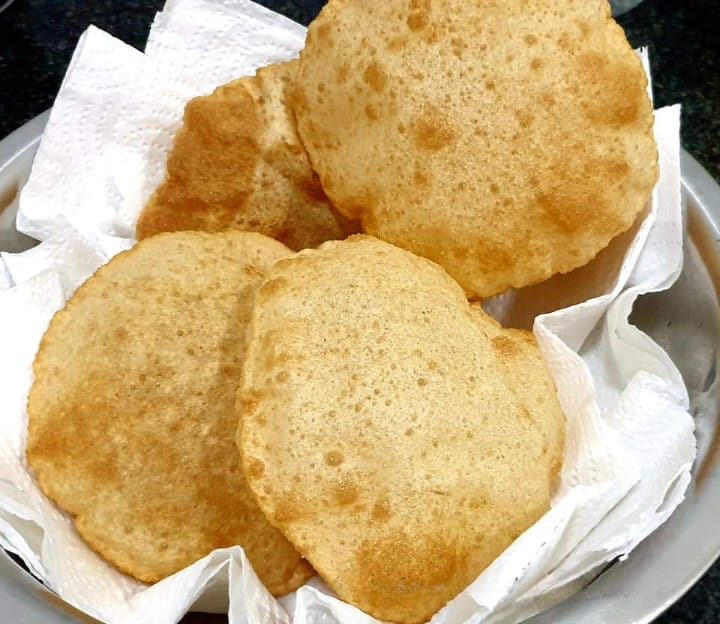Poori, also known as puri, is a popular Indian fried bread made from unleavened wheat flour dough. It is a versatile and widely enjoyed dish in Indian cuisine, known for its soft, fluffy texture and crispy exterior. Everyone craves for the Perfect Poori. In this article we will see some tips to achieve that.
To prepare poori, wheat flour is kneaded into a soft dough with water and sometimes a pinch of salt. The dough is then divided into small balls, which are rolled out into circular discs using a rolling pin. These discs are then deep-fried in hot oil or ghee (clarified butter) until they puff up and turn golden brown. The frying process creates layers within the poori, resulting in its characteristic fluffy texture.
Pooris are often served as a breakfast or brunch item alongside savory accompaniments such as potato curry (aloo sabzi), chickpea curry (chole), or lentil curry (dal). They are also enjoyed during festive occasions, celebrations, and religious ceremonies. Additionally, pooris can be served with sweet accompaniments like halwa or served plain with a sprinkle of sugar for a simple yet satisfying treat.
Due to its portability and long shelf life, poori is also a popular choice for picnics, travel, and as a street food snack. Its widespread popularity and simple yet delicious preparation have made it a beloved comfort food enjoyed by people of all ages across India and beyond.
Tips for Making Perfect Poori
Making perfect poori requires attention to detail and some practice, but following these tips can help you achieve that fluffy and crispy texture.
Use Fresh Ingredients:
Always use fresh wheat flour and make sure your sesame seeds are not rancid. Fresh ingredients ensure better flavor and texture.
Proper Dough Consistency:
Gradually add water to the flour mixture while kneading until you achieve a soft and pliable dough. Knead the dough well to ensure gluten development, which helps in puffing up the pooris.
Resting Time:
Let the dough rest for at least 10 minutes after kneading. This allows the gluten to relax, making it easier to roll out and resulting in softer pooris.
Rolling Technique:
When rolling out the dough balls, make sure to spread them evenly and slightly thicker than chapatis. Avoid rolling them too thin, as they may not puff up properly.
Oil Temperature:
Heat the oil in a deep pan on medium heat. The oil should be hot but not smoking. To test if the oil is ready, drop a small piece of dough into it; if it sizzles and rises to the surface gradually, the oil is at the right temperature.
Frying Process:
Gently slide the rolled-out poori into the hot oil. Once it starts to puff up, lightly press the top with a slotted spoon or spatula. This helps the poori to puff up evenly. Flip it over carefully and allow the other side to puff up as well. Fry until both sides are golden brown.
Drain Excess Oil:
Once the pooris are golden brown and puffed up, remove them from the oil using a slotted spoon and place them on paper towels to drain any excess oil.
Serve Immediately:
Pooris are best enjoyed hot and fresh. Serve them immediately with your favorite accompaniments like potato curry, chutney, or pickles.
By following these tips, you can make perfect poori that are soft, fluffy, and delicious every time.
Frequently Asked Questions
1. Can I use all-purpose flour instead of wheat flour?
- While wheat flour is traditionally used for making pooris, you can substitute it with all-purpose flour if needed. However, the texture and flavor may differ slightly.
2. How do I prevent my pooris from turning out oily?
- To prevent pooris from absorbing too much oil, ensure that the oil is at the right temperature before frying and avoid overcrowding the pan. Also, drain the fried pooris on paper towels to remove excess oil.
3. My pooris are not puffing up. What am I doing wrong?
- Pooris may not puff up properly if the dough is too stiff or if the oil temperature is too low. Ensure that the dough is soft and pliable, and that the oil is hot enough before frying.
4. Can I make the dough in advance and fry the pooris later?
- Yes, you can prepare the dough in advance and store it in the refrigerator for up to a day. Allow the dough to come to room temperature before rolling and frying the pooris.
5. Can I freeze leftover pooris?
- While it’s best to enjoy pooris fresh, you can freeze leftover pooris in an airtight container for up to a month. Reheat them in a preheated oven or toaster oven until heated through.
6. Can I add spices or herbs to the dough for flavor?
- Yes, you can customize the flavor of your pooris by adding spices like cumin, coriander, or ajwain to the dough. Herbs like chopped cilantro or mint can also be added for extra freshness.
7. How do I store leftover dough?
- Store leftover dough in an airtight container or wrapped in plastic wrap in the refrigerator for up to two days. Allow it to come to room temperature before rolling and frying.
8. Can I make gluten-free pooris?
- Yes, you can make gluten-free pooris using gluten-free flour blends like chickpea flour (besan) or a combination of rice flour and tapioca flour. Adjust the water quantity as needed.
9. My pooris are too hard. How can I make them softer?
- To make softer pooris, ensure that the dough is kneaded well and allowed to rest for an adequate amount of time. Adding a little yogurt or milk to the dough can also help in achieving a softer texture.
